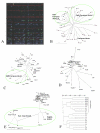Comparative genomics of Helicobacter pylori isolates recovered from ulcer disease patients in England
- PMID: 15916705
- PMCID: PMC1180443
- DOI: 10.1186/1471-2180-5-32
Comparative genomics of Helicobacter pylori isolates recovered from ulcer disease patients in England
Abstract
Background: Genomic diversity of H. pylori from many different human populations is largely unknown. We compared genomes of 65 H. pylori strains from Nottingham, England. Molecular analysis was carried out to identify rearrangements within and outside the cag-pathogenicity-island (cag PAI) and DNA sequence divergence in candidate genes. Phylogenetic analysis was carried out based on various high-resolution genotyping techniques.
Results: Analyses of virulence genes (cagT, cagE, cagA, vacA, iceA, oipA and babB) revealed that H. pylori strains from England are genetically distinct from strains obtained from other countries. The toxigenic vacA s1m1 genotype was found to be less common and the plasticity region cluster was found to be disrupted in all the isolates. English isolates showed a predominance of iceA1 alleles and a functional proinflammatory oipA gene. The English H. pylori gene pool revealed several Asian/oriental features. This included the predominance of cagA - glr (cagA right junction) motif types III and II (up to 42%), presence of vacA m1c alleles and phylogenetic affinity towards East Asian / Amerindian gene pools based on fluorescent amplified fragment length polymorphism (FAFLP) analysis and glmM sequence analysis.
Conclusion: Overall, our results demonstrated genetic affinities of H. pylori in England with both European and the Asian gene pools and some distinctive genetic features of virulence genes that may have evolved in this important European population.
Figures


Similar articles
-
Genetic characterisation of Helicobacter pylori isolates from an Argentinean adult population based on cag pathogenicity island right-end motifs, lspA-glmM polymorphism and iceA and vacA genotypes.Clin Microbiol Infect. 2004 Sep;10(9):811-9. doi: 10.1111/j.1198-743X.2004.00940.x. Clin Microbiol Infect. 2004. PMID: 15355412
-
Comparing genomes of Helicobacter pylori strains from the high-altitude desert of Ladakh, India.J Clin Microbiol. 2005 Apr;43(4):1538-45. doi: 10.1128/JCM.43.4.1538-1545.2005. J Clin Microbiol. 2005. PMID: 15814963 Free PMC article.
-
Association of iceA and babA genotypes in Helicobacter pylori strains with patient and strain characteristics.Antonie Van Leeuwenhoek. 2010 Oct;98(3):343-50. doi: 10.1007/s10482-010-9448-y. Epub 2010 May 8. Antonie Van Leeuwenhoek. 2010. PMID: 20454856
-
[High prevalence of VacA, CagA protein expression and presence of cag pathogenicity island in Japanese Helicobacter pylori isolates].Nihon Rinsho. 1999 Jan;57(1):17-22. Nihon Rinsho. 1999. PMID: 10036931 Review. Japanese.
-
[H. pylori genomics].Nihon Rinsho. 2013 Aug;71(8):1352-67. Nihon Rinsho. 2013. PMID: 23967664 Review. Japanese.
Cited by
-
Investigation of the association between clinical outcome and the cag pathogenicity-island and other virulence genes of Helicobacter pylori isolates from patients with dyspepsia in Eastern Turkey.Braz J Microbiol. 2014 Mar 10;44(4):1267-74. doi: 10.1590/s1517-83822013000400034. eCollection 2013 Dec. Braz J Microbiol. 2014. PMID: 24688521 Free PMC article.
-
Presence of cagPAI genes and characterization of vacA s, i and m regions in Helicobacter pylori isolated from Alaskans and their association with clinical pathologies.J Med Microbiol. 2020 Feb;69(2):218-227. doi: 10.1099/jmm.0.001123. Epub 2020 Feb 3. J Med Microbiol. 2020. PMID: 32011229 Free PMC article.
-
Helicobacter pylori vacA arrangement and related diseases: a retrospective study over a period of 15 years.Dig Dis Sci. 2009 Jan;54(1):97-102. doi: 10.1007/s10620-008-0327-6. Epub 2008 Jul 3. Dig Dis Sci. 2009. PMID: 18594981
-
Diverse characteristics of the CagA gene of Helicobacter pylori strains collected from patients from southern vietnam with gastric cancer and peptic ulcer.J Clin Microbiol. 2009 Dec;47(12):4021-8. doi: 10.1128/JCM.00504-09. Epub 2009 Oct 21. J Clin Microbiol. 2009. PMID: 19846630 Free PMC article.
-
Helicobacter urease: niche construction at the single molecule level.J Biosci. 2009 Oct;34(4):503-11. doi: 10.1007/s12038-009-0069-4. J Biosci. 2009. PMID: 19920336
References
Publication types
MeSH terms
Substances
LinkOut - more resources
Full Text Sources
Medical

